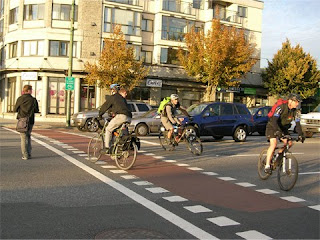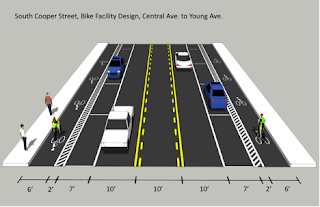For many years, municipal engineers and planners around the United States have been limited by outdated design standards for bicycle facilities in the United States.
Currently, due to outdated federal standards, many bikeway designs that are common in Europe and Canada -- like bike boxes, colored pavement markings, bike-only signals, and buffered bike lanes -- are still considered "experimental" in the U.S.
U.S. bikeway design guidelines are outlined in the Manual on Uniform Traffic Control Devices (MUTCD), a document that, amongst other recommendations, specifies that bike facilities should *stop* 20 feet in advance of intersections (the place where 50-70% of all collisions occur) and specifically prohibits "separated" bike facilities (the design norm in cities where mode shares tower in the double digits).
One of the major problems with outdated federal standards, as cited by Bike Portland, is that municipalities can't use federal money for improvements if they're not in compliance with the MUTCD. Another problem is tort liability: many engineering divisions fear being held liable for accidents in facilities not specifically recommended by the MUTCD. While few municipalities have been sued, and even fewer held liable, the concern is oft cited.
But according to Bike Portland, these traditional American design standards could be changing. And soon.
Mike Wetter, Senior Advisor to Portland Metro Council President David Bragdon,
says that in part due to Metro's work in raising this issue to DOT Secretary Ray LaHood's office last fall, the US DOT may soon give 'interim approval' to (innovative) designs which would expedite their use across the country.
We here in Memphis have recently felt these waves of change welling out of Washington.
You may have read about Memphis Mayor A.C. Wharton's 2010-2011 Bike Facilities Program announced a couple weeks ago, or read about the first installment in that campaign: The Horn Lake Bike Lanes. The kinds of recommendations in that article, painted stripes at high conflict points, are exactly the kinds of facilities that the DOT hopes to encourage.
Perhaps most excitingly for Memphians are plans currently under consideration to implement world class bike facilities in the heart of the city. In the past month, building on more than 2 years of work and innovation from community partners and business leaders, plans for a series of world class bicycle facilities have been proposed for Cooper St. in midtown Memphis.
The plans, which are far from finalized, are based on input from community residents, business owners, and bicycle riders. They propose implementing facilities which have been proven to increase the number of riders in the roadway while decreasing net injuries, and they have been reviewed by City Engineers and representatives of Mayor A.C. Wharton's staff. The Mayor's staff has continually emphasized the Mayor's interest in seeing innovative bicycle facilities implemented in Memphis.
Because the proposed facilities are still outside the jurisdiction of the MUTCD, a Request to Experiment (RTE) must be filed with the Federal Highway Administration (FHWA) to evaluate the effectiveness and safety of the facilities. The RTE also ensures the blessing of the Federal government.
City Engineers have expressed an interest in working with local advocates to assemble the RTE, and in an amazing demonstration of interest, the plans received attention from the FHWA. A call from the FHWA this week outlining their interest in working with Memphis to assemble an RTE was a sign that the federal government has a keen interest in implementing these innovative and effective bicycle facilities.
Bike Portland reports that standardization of bike boxes and painted bike lanes may be imminent. Portland transportation officials
want the US DOT to work in cooperation with the National Association of City Transportation Officials (NACTO, the city version of AASHTO), provide interim approval for several new (in the U.S.) bikeway designs, work with NACTO to develop the forthcoming "Cities for Cycling Urban Bikeway Design Guide" and implement the findings of an FHWA-sponsored fact-finding mission to bike-friendly cities in Europe that took place in May 2009.
Finally Earl Blumenauer, an Oregonian congressman second in the pantheon of great congresspeople only to Memphis' very own Rep. Steve Cohen, has been in productive dialogue with Secretary of Transportation Ray LaHood on advancing bike design standards. Blumenauer said
As the Secretary himself has noted, we’ll have to move beyond current design standards if we want to create truly livable communities, where people can walk and bicycle safely.
Things are happening fast now, fair readers. Stay tuned.





Thanks for the information, Anthony. Sounds very exciting. However, I have been confused as to the planned bike lanes in Cooper-Young. I attended the meeting at Peabody elementary several months ago that was organized by the city. In that meeting, they outlined a plan that resembled what you described as the current MUTCD standard where the bike lanes end prior to intersections. I was under the impression that that plan was the design they were going to implement in the next few months.
ReplyDeleteMore recently, I have seen the study that was at least partially facilitated by Revolutions that proposes three different variations of bike lanes for CY.
http://cooperyoung.org/wp-content/uploads/2010/08/CooperStreetFinal.pdf
So, is the design for bike lanes on Cooper finalized? The city said the bike lanes would be installed "this summer." If that is true, it seems a little late to be finalizing designs. If you know, can you clarify the status of the design for Cooper and the ETA?
Thanks,
mark
Hey Mark-
ReplyDeleteThanks for the questions.
No design has been finalized by the City.
Let me re-iterate this: no design has been finalized by the City.
At the Peabody meeting, which happened while I was in Denmark, the plan presented was not the finalized plan. I don't quite understand why, but that is the case. My sense, based on talking with folks around the community, is that there were many points of dissatisfaction, and the plan required additional refining.
As for an ETA, the new facilities proposed could be in place by the spring. Again, nothing is finalized-but depending on how things go in the next couple weeks, facilities could be in place by Spring 2011.
Finally, there is a possibility that none of the innovative facilities mentioned here will be included. In that case, the paving could be done in the fall 2010. To me, it seems best to wait a few months and get the best product rather than settling for a typical and outdated bicycle facility just to get it done sooner.
Thanks for staying engaged, Mark!
Thanks, Anthony. I agree with your comments. Who can we contact to encourage doing this right the first time?
ReplyDeleteAnthony,
ReplyDeleteWe are proud of all the work you and others have done, and are doing, to make Memphis a world class cycling city! Keep us posted!
Barry Smith
Past President
Memphis Hightailers Bicycle Club
Anthony are there any plans to take a few random parking spaces (and door zones 9' total) and make them into a small island for some single trunk smaller sized trees to make it more of a boulevard? Or are they just trying to maximize parking? Having a small island may be an opprotunity for an additional cross walk so people aren't jumping out from between cars like what happens at U of M on Southern.
ReplyDelete